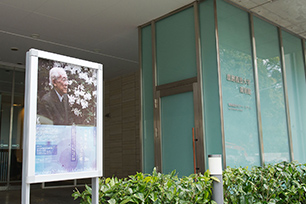Masato Naito, Professor of the Faculty of Letters and Director of Keio University Art Center
Learning Art, Feeling Art

The various genres in art—fine art, music, theater, dance, and film among others—are all products of the human mind, both past and present. We can also say that they express people’s thoughts and feelings in various forms without the use of language or letters.
The Art Center, located in the South Annex of Mita Campus, is a relatively new organization that was established in 1993 to research and share various forms of art. Since the Center’s primary focus is modern and contemporary art, we have continued our efforts to make art that is often avoided or regarded as difficult to understand more accessible so that it can be appreciated by others.
Some specific examples of the Center’s activities include holding classical and jazz music performances, conducting dance performances led by choreographers, showing films, and displaying art in the Art Space, a permanent exhibition room that opened in 2011. The Center does not limit the scope of its activities to members of the university but reaches out to the public at large through a wide array of activities.
These events play very important roles as opportunities for social education within the university, which is often thought of as a place for formal education. For instance, they can function as an important channel for the university to connect with the general public, starting with residents nearby, and we intend to continue our best efforts to fulfill such roles.
Incidentally, did you know that the Art Center has an active art archive service, which is still rare for art centers like ours in Japan, and that we handle preservation and research as well as services for browsing and display of various artistic materials which belong or have been entrusted to the Center? Two years ago, when donated material related to Junzaburo Nishiwaki was catalogued and went public, we started operation of a new archive called the “Nishiwaki Archive.” With that addition, five large art archives are presently available at the Center. Although advance reservation is required, these materials can be made available for inspection by researchers and fans alike, and recently they have become very popular, even attracting visitors from overseas. Furthermore, we receive many requests from museums and art museums off-campus for loan of these materials, and it seems that expectations are growing both domestically and internationally.
Our focus is to think and learn about art and to get in touch with it, not only in a confined space but in the context of the living world. The most important task for us here at the Art Center is to have each one of our staff play an active role in making that focus a reality.
*Position titles, etc., are those at the time of publishing.
